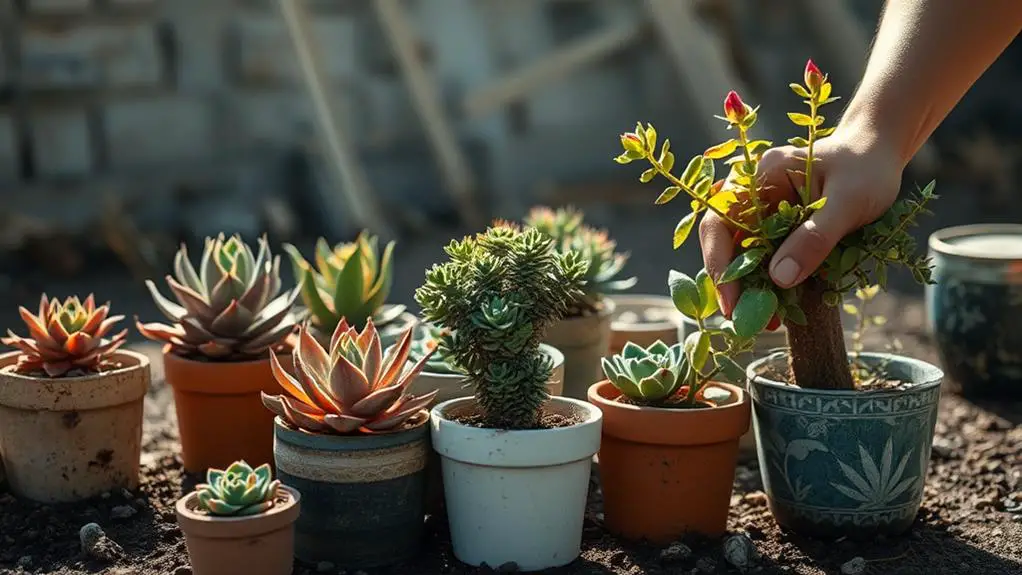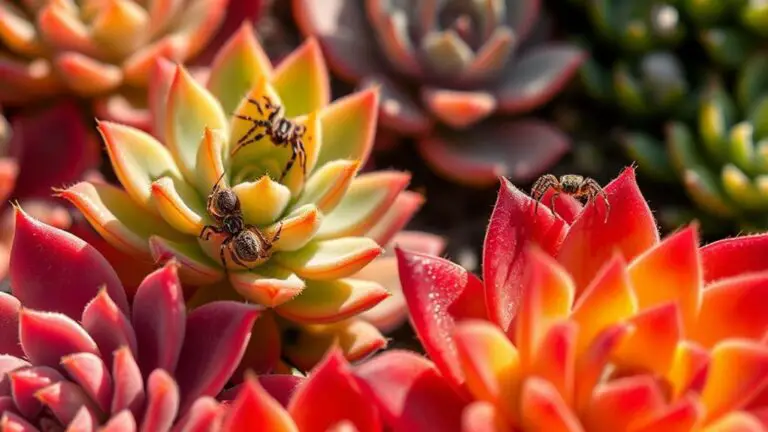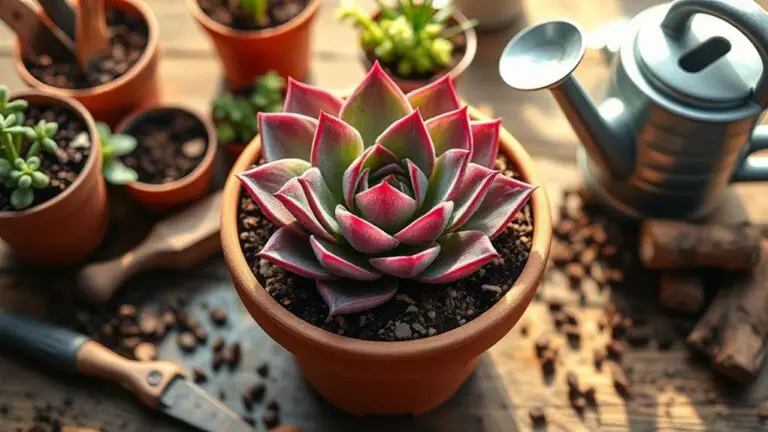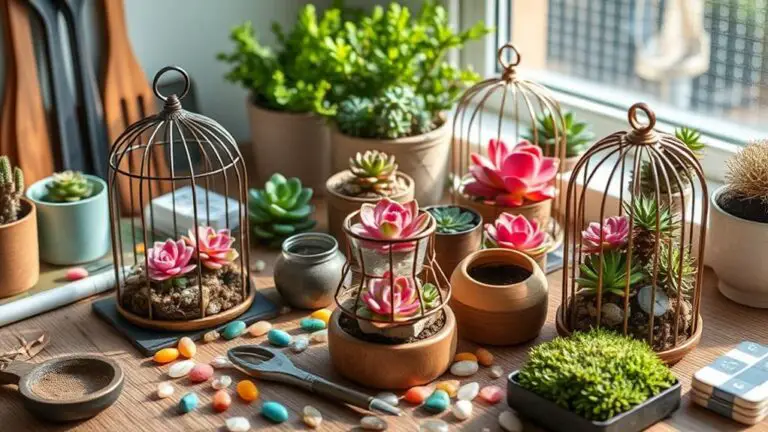7 Things You Should Not Do With Newly Arrived Succulents
When your new succulents arrive, you might feel enthusiastic to care for them, but there are essential steps to avoid if you want them to thrive. Don't expose them to direct sunlight straight away, as their delicate leaves can scorch. Resisting the urge to water them immediately is also important; their roots need time to acclimate and avoid rot. Additionally, hold off on fertilizing to prevent root burn. Curious about the other missteps that could jeopardize your succulent's health? Let's explore some more common mistakes you might not be aware of.
Expose to Direct Sunlight
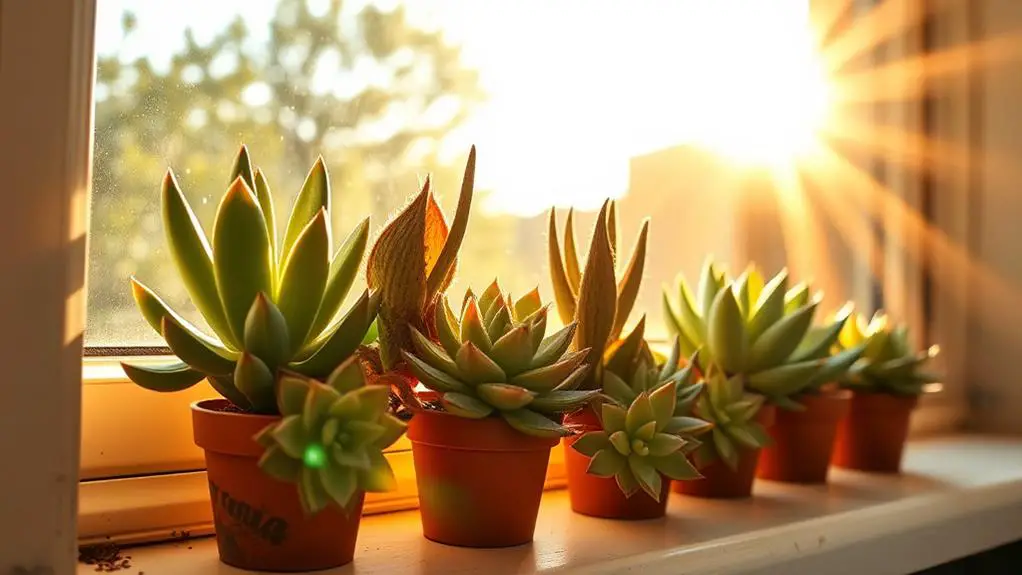
When you bring newly arrived succulents home, don't rush to place them in direct sunlight. These plants need time to acclimate and recover from any stress they experienced during shipping. If you expose them to direct sunlight right away, they can get sunburned. This might cause their leaves to become scorched or discolored, which nobody wants.
Instead, start by keeping your succulents in bright, indirect light for at least 2-3 days. This helps them maintain moisture levels and supports healthy root establishment.
After they've had some time to settle in, you can begin a gradual increase in their sunlight exposure. Over the course of a week, slowly move them to spots with more direct light, but keep an eye on them.
Look out for signs of stress like wilting or discoloration. These signs mean your succulents aren't ready for full sun yet and need a bit more time in indirect light.
Water Immediately
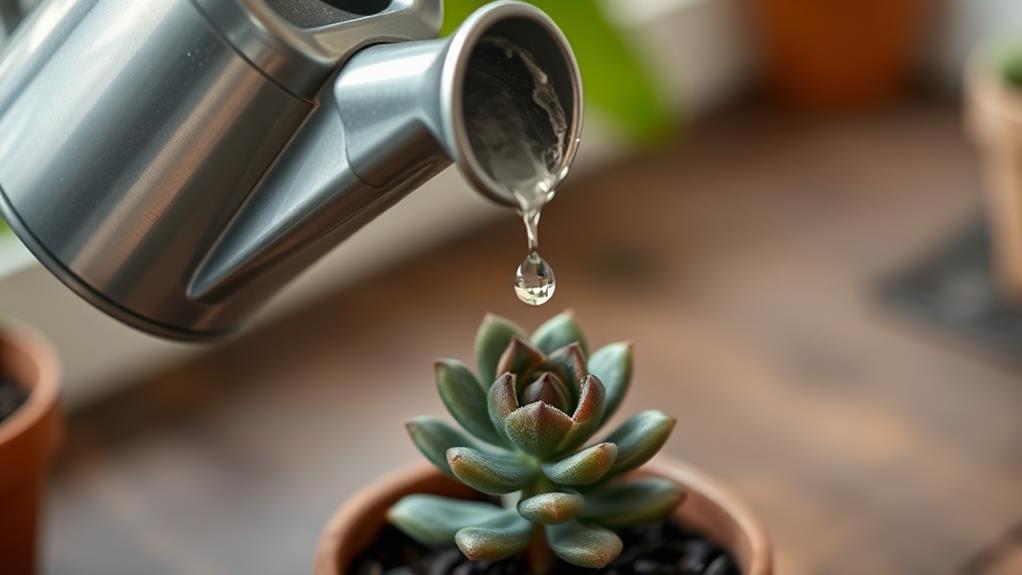
When you get new succulents, don't water them right away.
Check the soil moisture first and make sure it's completely dry to prevent root rot and stress reactions.
Giving them a few days to settle in indirect light without water helps them adjust better.
Check Soil Moisture
Getting your newly arrived succulent off to a good start begins with closely monitoring the soil moisture. You might think watering them immediately is the best way to help, but it's not. Succulents often go through shipping stress and need some time to adjust. If you water them right away, especially if the soil is still moist from shipping, you risk causing root rot.
Instead, give your succulents a 2-3 day healing period. During this time, any unhealed wounds from the journey can recover. This is essential because these plants need to absorb water without additional stress.
To check if the soil is dry enough, you can insert a stick into the soil. If it comes out clean and dry, it's safe to water. But if it comes out moist, wait a bit longer.
Monitoring the soil moisture closely after your succulents arrive helps you prevent overwatering, which is a common issue. Too much water can weaken the plant and damage the roots. By waiting until the soil is completely dry, you'll give your succulent the best chance to thrive in its new home.
Prevent Root Rot
Preventing root rot is essential for the health of your newly arrived succulents. When your succulents first arrive, resist the urge to water them immediately. Watering can lead to root rot, especially if the soil is still moist from shipping. Before doing anything, check the soil moisture first. Use a stick to test the soil; if it's dry, you can proceed, but if it's still damp, wait a few days.
Allow your succulents to acclimate for 2-3 days in indirect light before you introduce any watering routines. This waiting period lets any unhealed wounds from shipping dry out, reducing the risk of rot.
Overwatering is one of the most common mistakes made with succulents, so always verify the soil is completely dry before adding water.
When you do water, make sure to do it thoroughly but infrequently. Succulents are designed to thrive in dry conditions, so waterlogged soil can suffocate their roots and lead to root rot.
Avoid Stress Reactions**
Often, succulents arrive stressed from the shipping process, and your first instinct might be to water them right away to help them recover. However, this can actually make things worse. When succulents are shipped, they often have unhealed wounds, and watering right away can lead to root rot.
It's essential to let the soil dry out completely before you water them. Instead of watering immediately, wait at least 2-3 days. This gives your succulents time to acclimate and for any wounds to close.
Monitor your plants closely for signs of stress, like wilting or yellowing leaves. These signs mean they mightn't be ready for water yet.
When you do water them, make sure the soil is dry. Gradually reintroducing water helps the roots establish themselves without overwhelming the plant.
Fertilize Right Away
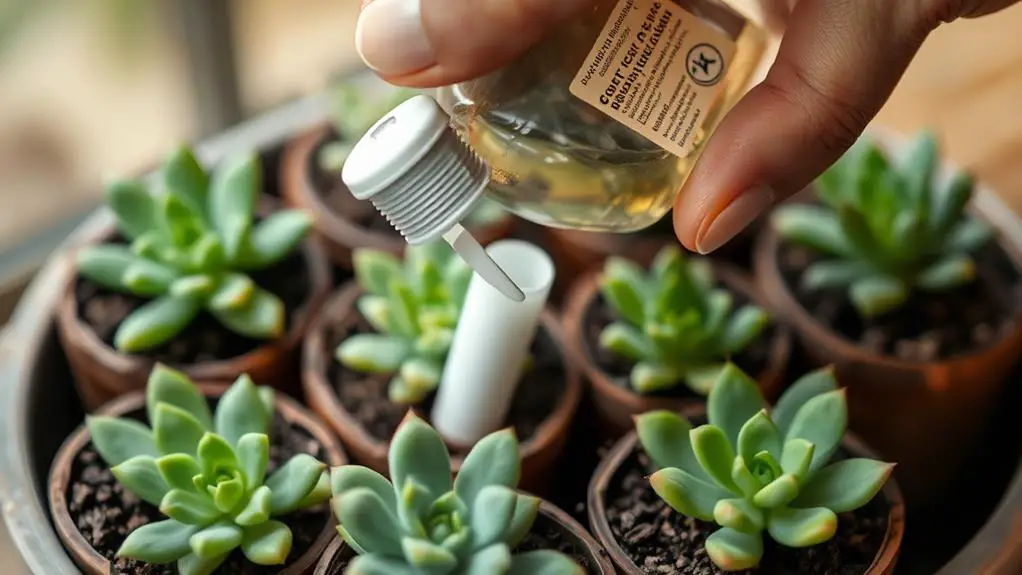
Fertilizing your new succulents right away might seem helpful, but it can actually cause root burn and increase their stress.
Because they're already dealing with the shock of shipping, they can't handle extra nutrients right away.
Instead, give them a few weeks to settle in, monitor the soil moisture, and provide good light to help them recover and thrive.
Risk of Root Burn
Introducing fertilizers to newly arrived succulents right away can be a risky move that often leads to root burn. When succulents arrive, their root system is usually stressed from shipping and not ready to absorb nutrients effectively. This can lead to problems like root burn, especially if there's excess water in the soil.
Fertilizing too soon can overwhelm their delicate roots and cause chemical burns, resulting in plant decline or even death.
Here's what you should do instead:
- Allow a Healing Period: Let your succulents settle in for 2-3 days before considering any fertilizing. This helps their compromised root system recover.
- Acclimate First: Give your succulents at least a month to adjust to their new environment. This guarantees they're healthy and ready to take in nutrients.
- Dilute Fertilizer: If you decide to fertilize, use a diluted solution. Introduce it gradually to avoid shocking the plant.
- Monitor Recovery: Only fertilize once you see signs of recovery and established roots. This shows the plant is ready to handle additional nutrients.
Increased Stress Levels
After understanding the risk of root burn, let's discuss another critical issue: increased stress levels from fertilizing right away. When new plants arrive, they often need some time to adjust to their new environment. Fertilizing them immediately can lead to root burns because these stressed succulents aren't ready to absorb nutrients properly.
Newly arrived succulents typically need an adaptation process of 2-3 days in indirect light. During this period, they're particularly vulnerable. Shipping stress can hinder their ability to handle extra nutrients, making the risk of over-fertilization higher. It's important to give them this time to settle in and recover from the journey before adding any fertilizer.
To guarantee successful acclimation, wait until the roots are well-established before introducing fertilizers. This promotes healthy growth and prevents nutrient buildup in the soil, which can harm the succulent's overall health.
Over-fertilizing during the initial stage can cause more harm than good, potentially affecting their recovery process.
Repot Instantly

Repotting newly arrived succulents instantly can do more harm than good. When your succulents first arrive, they've already gone through the stress of shipping. Jumping straight into repotting might overwhelm them.
It's crucial to give them time to acclimate to their new environment, allowing their succulent roots to settle and recover.
Here's what you should do instead:
- Wait at least 2-3 days: This allows any unhealed wounds from shipping to heal, reducing the risk of rot.
- Monitor light and humidity: Give your succulents about a week to adjust to the light and humidity levels in their new home.
- Check for signs of recovery: Confirm your plant is showing signs of establishing roots and overall health improvement before repotting.
- Observe moisture levels: Make sure the soil isn't too wet or too dry. This balance helps your succulent roots grow healthier.
Ignore Adaptation Period
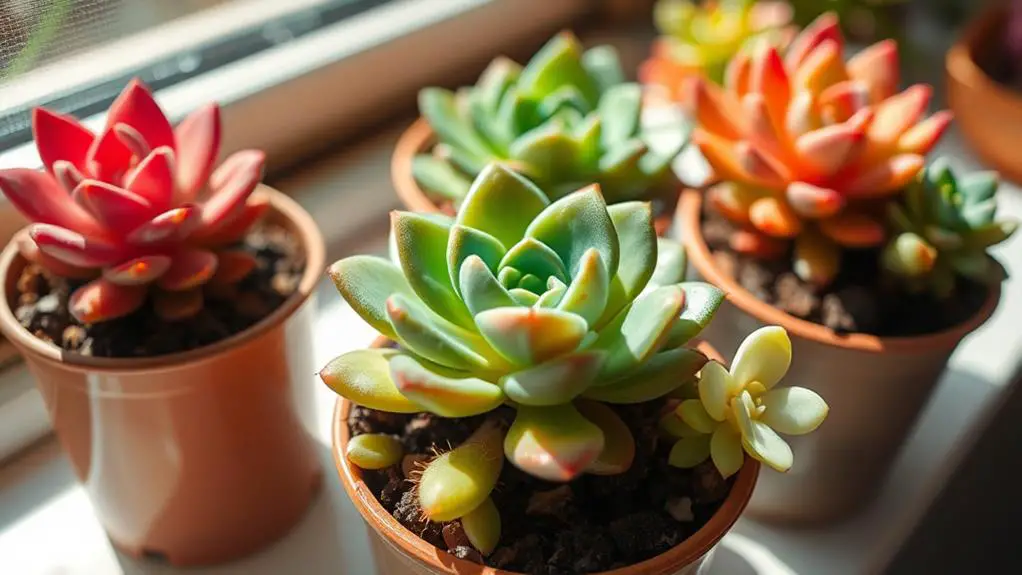
Ignoring the adaptation period for newly arrived succulents can set your plants up for failure. When your succulents first arrive, they need time to adjust to their new environment and recover from the stress of shipping. This adaptation period can last anywhere from 1 week to 1 month. During the first 2-3 days, place your succulents in indirect sunlight to prevent sunburn and help them acclimate gradually.
Here's a helpful guide:
| Day Range | Action |
|---|---|
| Days 1-3 | Place in indirect sunlight |
| Days 4-7 | Observe for signs of stress |
| Week 2 | Gradually increase the light exposure |
| Week 3 | Continue observing, adjust light as needed |
| Week 4+ | shift to full light, if appropriate |
Signs of stress, like yellowing leaves or slowed growth, are common during the adaptation period. These signs indicate that your succulent is focusing on root recovery. If you ignore the adaptation period, you'll risk excessive leaf drop or root problems.
Gradually increasing the light exposure after the initial acclimation phase is essential. This process supports healthy growth without overwhelming your plant. By giving your succulents the time they need to adjust, you'll set them up for a thriving future. Remember, patience is key!
Mix With Established Plants
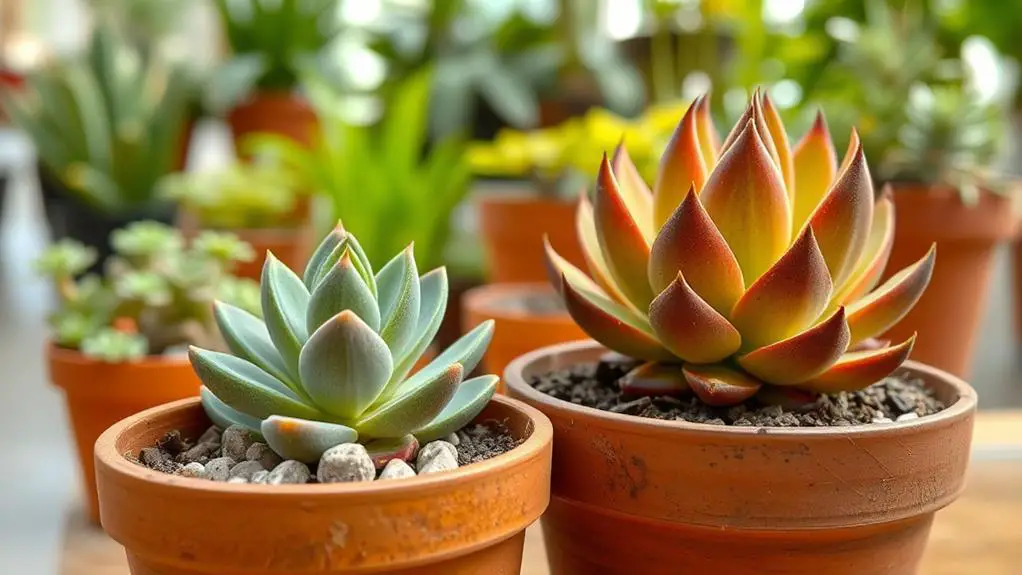
Mixing newly arrived succulents with established plants can be a recipe for disaster. When your new succulents arrive, they need some time to adjust to their new environment. This acclimation period, usually about 1 week to 1 month, is essential for their health and well-being.
Here's why you shouldn't mix them with your established plants:
- Pests and Diseases: Newly arrived succulents can bring pests or diseases. These issues can easily spread to your established plants, causing a lot of trouble in your garden.
- Resource Competition: New succulents are already stressed from shipping and need all the resources they can get. Competing with established plants can hinder their growth and recovery.
- Different Watering Needs: Newly arrived succulents often need different watering schedules. Mixing them with established plants can lead to overwatering or underwatering, which can harm both sets of plants.
- Unhealed Wounds: Shipping can cause minor injuries to your new succulents. These unhealed wounds make them more vulnerable, and mixing them with other plants can cause further stress or damage.
To keep your plants healthy, isolate newly arrived succulents for a few weeks until they show signs of stability.
Use Non-Draining Soil
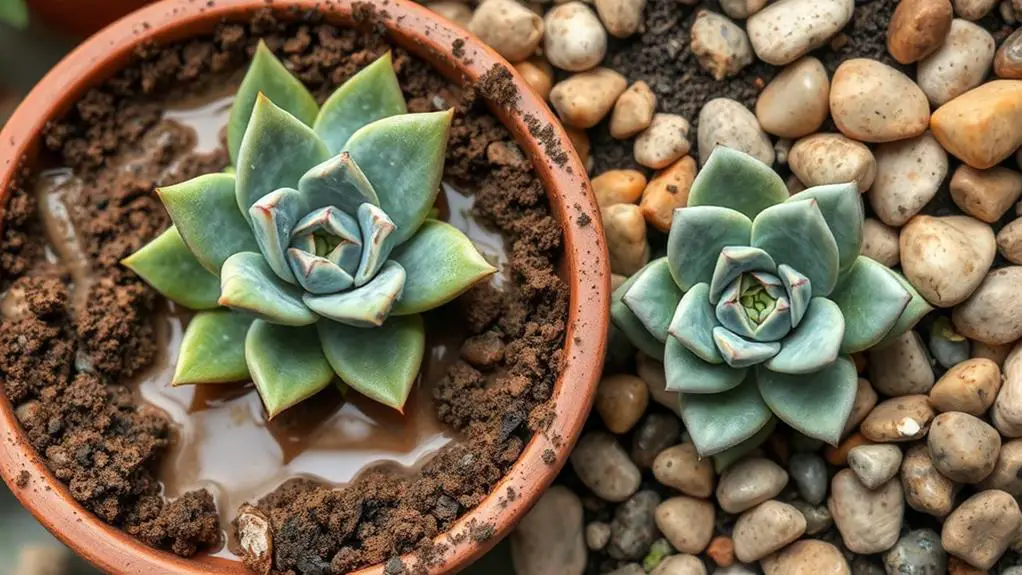
If you use non-draining soil for your newly arrived succulents, you're setting them up for failure. Succulents are unique plants that need well-draining soil to thrive. When you use non-draining soil, it retains too much moisture, which can lead to root rot.
Root rot is a common problem that occurs when the roots sit in water for too long, causing them to decay. This can ultimately kill your succulent.
Regular potting soil holds more water than succulents can handle. That's why it's essential to use succulent soil or cactus soil, which is specially designed to provide excellent drainage. These mixes often contain sandy or porous materials that allow water to flow through quickly, preventing waterlogging.
If you can't find pre-mixed succulent soil, don't worry. You can make your own by combining regular potting soil with additives like perlite or pumice.
These materials help improve drainage and keep the soil aerated, ensuring your succulents stay healthy.
Frequently Asked Questions
What Do I Do With My Succulents When I First Get Them?
When you first get your succulents, inspect them for any pests or rot. Let them acclimate in indirect light for a few days, allow bare roots to heal, avoid watering immediately, and don't fertilize right away.
What to Do After Buying Succulents?
After buying succulents, place them in indirect light for 2-3 days. Let any unhealed wounds heal before planting. Don't water immediately; wait until soil is completely dry. Gradually increase sunlight and monitor for stress or disease.
Why Shouldn't You Touch Succulents?
You shouldn't touch succulents because it disrupts their acclimation process and can cause stress or damage. Handling them might introduce bacteria or pests, worsen unhealed wounds, and lead to issues like leaf drop or softening.
How Do You Take Care of Newly Planted Succulents?
To care for newly planted succulents, let them heal in indirect light for 2-3 days, water only when the soil's dry, use well-draining soil, avoid immediate fertilizing, and monitor for stress signs to adjust care.
Conclusion
Taking care of your new succulents doesn't have to be stressful. Just remember to avoid direct sunlight and don't water them immediately. Give them time to adjust, and hold off on fertilizing and repotting. Keep them separate from your other plants for a while, and always use well-draining soil. By following these simple steps, you'll help your succulents thrive. You've got this, and soon your plants will be healthy and happy!

